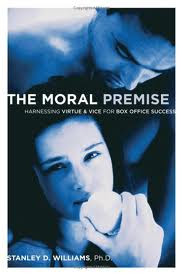Seems like everyone who works in the media business has a theory on which elements make up a good story. There certainly is no shortage of resources. A quick search on Google will reveal countess books, videos and seminars on script writing, story structure, and story concepts. You can find everything from the heroes journey to the moral premise. But who’s right?
Who offers the best advice on story structure? Is it Robert McKee and his book, Story? Or is it Christopher Vogler and his book, The Writer’s Journey? Or maybe Joseph Campbell and his book, The Power of Myth? You pick it. I’m not sure there’s a right or wrong answer.
To be honest, one of my personal favorites is The Moral Premise, harnessing virtue and vice for Hollywood success from Stanley D. Williams. His principle states that “some psychological vice leads to some psychological detriment”. But, some physical virtue leads to some physical betterment. He makes the case that whenever this principle is used, it results in substantially better box office results. In other words, it resonates with audiences.
I certainly don’t claim to be an expert on script writing. However, as a moviegoer and someone who has been teaching media for years, here’s are the elements I want to see in a screenplay that ultimately have the potential to be a great movie.
1. A killer concept. It all starts with a great idea. Is your idea big enough to fill the big screen for two hours and hold the audience captive? It must be compelling and filled with big themes. Now a great concept will not necessarily translate into a great movie. There are many other elements that have to be taken into consideration. However, it is essential in building a strong foundation. Examples of a killer concept are Inception and District 9.
2. Story Structure. I’m not talking about the three-act structure. The best way to describe it would be more like story design. It’s how you tell your story. Most screenplays start at the beginning in a linear fashion. But let’s make it interesting? What if we start at the end and move backwards or start in the middle? And it’s always important whose point-of-view the story is being told from. Some good examples are Pulp Fiction and One Hour Photo.
3. Strong visual elements. Obviously, movies are meant to be visual. If it’s not on the page, it’s certainly not going to be on the screen. Make it visual. Give your audience something to look at. Even good low-budget movies will find a way to make it visual. Examples of small stories that make it visually interesting are Get Low and Northfork.
4. Conflict. Hey, I realize this is a given. There isn’t one book or seminar that doesn’t preach the merits of conflict. If there’s no conflict, there’s no story. Even the Bible is based on the stories of conflict.
Keys to a Good Story - part 1
Info Post




0 comments:
Post a Comment